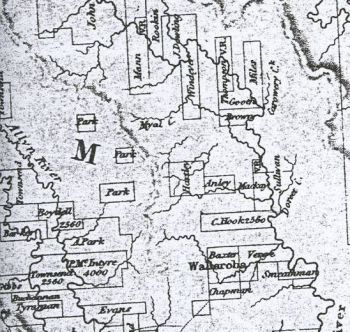Ferdinand Anley
Mountjoye - Map 3
With thanks to Paul Anley for supplying information about the Anley family. Panley@sydneyports.com.au
Arrival in Australia
Ferdinand Wright Anley was born on 30th October 1788 to Ferdinand and Mary Elizabeth Dumaresq. He arrived in Australia on the Calista from London via Hobart in April 1828.Land Grant
In Australia he was granted 1280 acres of land in 1828 in the County of Durham and another 2560 acres in 1829.
Ferdinand Anley's grant Mountjoye was situated on the road from Wallarobba to the Upper Williams River area.
Travellers to the farm would pass the north west corner of Matthew Chapman's The Grange estate and then cross the Wallarobba Creek and follow its course through the grants of A.M. Baxter and John Verge where there was a village reserve.
John Hooke's grant was next and situated to the east of Tabbit Hill. After crossing Tabbit Creek the estate belonging to Ferdinand Anley could then be found. [1]
Assigned Convict Workers
Convicts and workers assigned to Ferdinand Anley included :William Spellman arrived per Ann and Amelia 1825
Thomas Jonas arrived per John Barry 1819
Henry Martin arrived per Countess of Harcourt 1822
Thomas Lamb per John 1829
George Reynolds per Lonach 1825
Ferdinand Anley ran into financial difficulty in 1829 and was imprisoned in Newcastle Gaol as a debtor in 1830.
Death
He died in July 1837 age 49.Description of Mountjoye
The estate was advertised for sale in 1841 and described as being only one mile from the rapidly thriving township of Dungog and a few miles from Clarencetown, where sailing vessels and steamers were constantly visiting. The soil was of an excellent description for agricultural purposes and being well watered would make a first rate dairy farm of cattle station. There was a fine fresh water creek running through the centre of the property. The country was fine open forest land and was partially cleared.[2]Clarke Irving was owner of this land in 1848
Captain Philip Nicholl Anley
Philip Nicoll Anley was related to Ferdinand Anley. He was born on 30th October 1795 in Maitland St. Clements Jersey to Peter Bonamy Anley and Mary Nicolle. He married Harriet Allez of Guernsey in July 1821 and served in Ireland 1826 -7, Rochdale 1828 and Chartham in 1829 before departing England for New South Wales in September 1830.17th Regiment
Philip Nicoll Anley was a Captain of 17th Regiment of Foot Leicestershire - also known as 'The Lilywhites, the Green tigers and later 'Bengal Tigers'. They served in India then in 1831 - 1835 at Parramatta and Maitland. He arrived in Hobart, Tasmania on the convict ship 'John' on 28th January 1831, and was appointed Justice of the Peace soon afterwards.Magistrate
In August 1831, Anley served as Magistrate in a controversial rape case at Maitland NSW, (R v. Foley). Timothy Foley was later tried in Sydney and found not guilty as no evidence was offered.Captain Anley was promoted to Major in July 1833. As part of his duties as Magistrate he was present at all corporal punishments carried out at Paterson. Select here to see the Return of Corporal Punishments inflicted by Sentence of the Bench at Paterson from 1st September to 1st October 1833 in the presence of P.N. Anley.
Assigned Convict Servants
Convicts assigned to Philip Nicholl Anley included:Daniel McCullum - per John
Eliza Kirkpatrick per Eliza
Eleanor Toohey per Southworth
Return to England
In October 1834 it was announced in the Sydney Gazette that he would be returning to England. Fifty six residents of the Maitland area signed a letter thanking Captain Anley for his work as a Police Magistrate, however it was around this time that an outspoken 'Correspondent' of the Sydney Gazette remarked on the difficulties of appointing Officers in marching regiments to be Police Magistrates.'When they have gained experience, which, in a Magistrate, constitutes everything, why then off they go to India, and another Officer takes the Magisterial Chair, to be drilled in the same manner into office; and by the time he is competent, why off he goes also. Surely the Government could find gentlemen in every way capable of discharging the duties of a JP and who with a more liberal salary than Police Magistrates are at present allowed who would be willing to establish themselves as fixtures. If we want disciplinarians retired officers both of the army and navy are made of 'Stern Stuff'.
Phillip Anley departed NSW for England in charge of an invalids detachment on 22nd February 1835 on the Roslyn Castle. He sold his commission on 10th February 1837 in England and died on 16th November 1877 at Marylebone.
Notes and Links
1). Origins of Name places in Dungog/William River district - Dungog Chronicle 21 November 1939References
[1] Maitland Mercury 15 October 1887 - from Tegg's Pocket Almanac 1842[2] Australasian Chronicle 4 May 1841
[3] Sydney Gazette 16 April 1828
↑